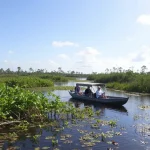For a long time Hickerson and her colleagues felt certain that Flower Garden Banks was relatively safe. Additionally to federal protection, the remoteness from the reef leaves it largely unmolested by individuals. Fling Charters, in Freeport, may be the only recreational supplier serving the website, as well as many experienced divers don’t imagine it’s worth time to help make the trip.
Until 1993, when she was employed to sign up inside a fish count in a nearby reef, the Australian-born along with a&M-educated Hickerson was certainly one of individuals skeptics. “As a snobby Australian I figured, ‘Why would i would like to join in the Gulf?’ ” she states. “And I acquired lower there and it was amazed.Inches
 Hickerson aboard the RV Manta on September 3, 2013.
Hickerson aboard the RV Manta on September 3, 2013.
Photograph by John Embesi/FBGNMS
Hickerson started working in the sanctuary two decades ago like a volunteer—she really compensated a babysitter to look at her daughter so she could benefit from the privilege of offering her labor free of charge. In 1997 she was hired on as part-time research coordinator and went full-time the year after. Nowadays she keeps a workplace near the Galveston Seawall, around the second floor of NOAA’s local facility, that is housed within the decommissioned Fort Crockett. But a lot of her most significant jobs are done aboard the Manta, which bunks an investigation group of ten along with a crew of 4 and boasts retracting dive ladders, a 7-horsepower winch with one 1000 ft of cable, wet and dry areas for analyzing samples from remotely operated underwater vehicles, and, this being Texas, a grill.
And today it’s a criminal offense lab of sorts. Standing within the Manta, Hickerson gestures in a map on the Television screen. “This may be the hot zone,” she states, pointing for an area in red. “These would be the other impacted areas,Inches she continues, pointing for an orange mass. “Why could it have been so localized? We’ve never witnessed something similar to this before.”
Since This summer, Hickerson and her network of specialists in academia and government happen to be trying to puzzle out what, exactly, became of the reef. Their first task was to eliminate exactly what the offender wasn’t, to get rid of the straightforward and apparent before getting to more-exotic ideas. One factor Hickerson understood could be that the die-off wasn’t a bleaching event—it happened too rapidly and demonstrated no usual signs. A couple of other scenarios happen to be excluded. In September NOAA reported it had reviewed boat traffic in the region and located hardly any activity, which makes it highly unlikely the die-off was brought on by pollutants that were dumped within the water. Nor will it seem to be associated with the gas and oil or shipping industries, in order to some kind of disease almost as much ast cats and dogs and individuals can’t all catch exactly the same cold, there isn’t any ailment that would affect barrier and sponges and ocean urchins.
What exactly was the offender? One possible partial reason behind the die-off may lie within this year’s weather patterns. This summer time was the greatest on record water temperature was 87 levels at depth once the die-off was detected. That’s 3 levels above 84, the twenty-year average with that date as well as in that place.
Earlier this summer time seemed to be a wet one, and also the runoff in the Trinity and Brazos rivers might have dumped pollutants in to the Gulf and decreased the salinity. Using various data-gathering devices, A&M’s Steve DiMarco noted “uncharacteristically low salinities” within the Gulf per month prior to the die-off. That’s likely not really a coincidence corals need relatively salty water to thrive.
DiMarco also suspects that throughout the summer time there is an upwelling event, a phenomenon by which water increases from below to exchange surface waters which have been pressed away, typically through the wind. That will have stop oxygen at the end from the reef, which may have placed further force on it.
Sarah Davies, a barrier biologist in the College of New York who shipped on the Manta in August, believes that these kinds of occasions would create favorable conditions for bacteria or any other microorganisms, that could have then cheated the reef’s vulnerable condition. “I’ve never witnessed anything enjoy it,Inches Davies states of her trip to the reef. “I’ve proven photos to individuals and they’re like, ‘Holy crap, what went down?’ ”
Hickerson thinks that DiMarco and Davies are basically on course. She suspects it was not just one cause but a number of unfortunate occasions that wiped out from the reef. She’s, inevitably, place in mind from the plight of her native country’s Great Barrier Reef, which she states would be a casualty of “years of insults tossed in internet marketing. It’s just like a one-two punch. For reefs declining worldwide it’s not merely one factor that kills them. I am not sure we’ll have an absolute answer by what happened here.”
In Galveston, data still dribble in, even while the analysis continues to be complicated with a nonlethal bleaching event in areas of banks. A few of the affected corals happen to be resistant previously to bleaching, which implies that they’re going to happen to be weakened by whatever caused the die-off. Subsequent dives have revealed dead sponges in other locations, meaning the die-off might be more prevalent than formerly believed.
Because it seems the die-off has ended, though, the sanctuary has lifted its recommendation that divers steer clear of the site. But Fling Charters co-owner Sharon Cain states her outfit is keeping its customers off to allow the corals recover as well as they are able to. There are many other areas in the region with healthy, Technicolor reefs for divers to gawk at.
Hickerson is anxious in regards to a place that’s, in this way, both her workplace and her vacation home. But her bigger problem is a harsh and global one. “Our world is principally water,” she states. “We need to keep our oceans healthy to keep our species healthy. When the corals aren’t healthy, we all know something’s wrong.”
Tags:
Atmosphere, Science, barrier reefs, Gulf Coast
Resourse: http://texasmonthly.com/articles/gulf-of-mexico-barrier-reefs/



